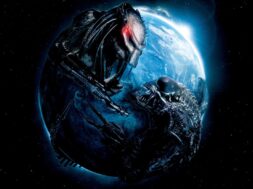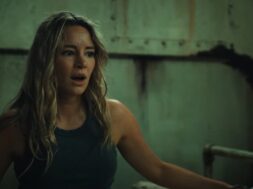Alice in Wonderland Meets H.P. Lovecraft: 10 Fun Things We Learned from the ‘Underwater’ Bonus Features
This article contains spoilers.
Now available on Digital and Blu-ray, director William Eubank’s Underwater has come home this week with over an hour of special bonus features, including three 20-minute featurettes, 15-minutes of deleted/extended scenes, an alternate ending (with optional commentary; both exclusive to the film’s Digital release) and a feature film commentary track.
It’s a robust package that dives relatively deep into the production, highlighting just how much work (and money) 20th Century Fox and the filmmakers put into bringing the aquatic horror tale to the big screen earlier this year. And at a time when home video bonus features are being scaled back, it’s damn sure nice to see a little bit of effort put into the release.
Here are just 10 fascinating things I learned from the commentary and various featurettes…
1) Kristen Stewart Insisted on Her Character Dying
Underwater‘s final act sees Kristen Stewart’s Norah sacrificing herself to blow up the film’s big monster, though she mostly has little say in the matter due to the only remaining escape pod being damaged. In the alternate ending, however, Norah is able to get that last pod working and escape before it’s too late. In the optional commentary track for the alternate ending, Eubank notes that though Stewart was game for filming a version of the ending wherein her character survives, she ultimately felt that Norah needed to give her life to the cause.
2) The Suits Worn By the Actors Weighed 100 Pounds
The “Production” featurette included with Underwater‘s home video release spends some time highlighting the incredibly impressive underwater suits worn by the characters, which weighed a whopping 100-pounds each. As you might imagine, this made it hard for the actors to move around; as Jessica Henwick notes, the suits weighed almost as much as she does. “I directed part of the day in one of them, and I just had sweat dripping down my face,” Eubank recalls. “This is the hardest shoot I will ever do in my life,” Henwick says during an on-set interview.
The suits, described in one of the featurettes as being “wearable submarines,” were such a crucial part of the film that Eubank viewed them as cast members in and of themselves.
3) The Underwater Scenes Were Filmed With No Water At All
The plus side to those bulky, cumbersome suits? They slowed down the actors and helped to sell the illusion that the characters were moving through water, when oftentimes they were not. For the portions of the film where the characters are walking along the ocean floor, they were actually walking on a sand-covered set. All of the surrounding water was then added into the mix in post-production. The stunt coordinator was tasked with further slowing down the movements of the actors to replicate the look and feel of their characters moving underwater.
Stewart explains, “What they did was put us on wires, in the suits, so we could kind of walk with an implied buoyancy. We had this suspended walk. With a particular frame-rate, they were able to make it look like we were genuinely submerged.” The combination of the suits, wires and frame-rate adjustments allowed for smooth, slowed down movements.
4) Green Screen? More Like Black Screen
You might be surprised by how much of Underwater was executed practically on set. “Unlike doing a lot of green screen work, we did a lot of this kind of black screen,” star John Gallagher Jr. notes in the “Production” featurette. “The set was kind of plunged into darkness, with specific lighting. For the most part you’re just out there on a dark stage. And I actually kind of enjoyed those days, because you don’t really know what you’re looking at and what’s happening and instead of staring down a big bright green screen, you’re just looking out into darkness.”
Rather than creating a deep sea world in post-production, it was largely created live on set. With the exception, of course, of the water, which was digitally inserted into the film.
5) There’s an Alternate Version of the Movie With a Real Bunny
A 3-minute bonus feature titled “Real Bunny Montage” is presented with zero explanation, and it reveals that the stuffed bunny T.J. Miller’s character is carrying throughout the movie was sometimes replaced by a very real bunny instead. I asked Eubank about this, and he explained to me that he did it on purpose, “so T.J. would think we were going to use the real bunny, and he treated the stuffed bunny like he thought it was the real bunny.” He added, “We would only do like a take with the real bunny. And then have the stuffed bunny the rest of the time.”
In other words, the movie was shot with a real bunny and a stuffed stand-in, and the only footage that was actually used was the footage with the fake bunny. But if you look closely towards the end of the film, as Smith is being closed into his escape pod, you can see that the stuffed bunny he’s handed by Norah becomes, just for a moment, a living, breathing bunny!
6) Underwater is a Monster Movie Homage to Alice in Wonderland
Why is there even a bunny at all in the movie, you ask? Well, there’s actually a reason for that. As William Eubank explains in the commentary track, he envisioned Norah’s story as a sort of monster movie take on Alice in Wonderland, with Norah/Alice traveling deeper and deeper down the rabbit hole. There are several nods to this allusion throughout the film, the first of which is a Queen of Hearts card that appears on the “Lavatory” sign in the opening scene.
“There’s a lot of cool nods to Alice in Wonderland,” Eubank explains. Another nod can be found on Paul’s (T.J. Miller) chest; he’s sporting a rather large tattoo of the iconic Cheshire Cat.
7) The Film’s Monsters Are Called “Clingers” and the “Behemoth”
None of the characters actually give names to the monsters in the film, but the bonus features let us know that the filmmakers named them “Clingers” and “Behemoth.” The “Clingers” are the tall, lanky, humanoid creatures that the characters are dealing with throughout much of the film, and it’s in the final act that we meet the Kaiju-sized “Behemoth.”
And speaking of those underwater terrors…
8) The Creatures Were Originally Much Different Looking
There’s a bunch of early creature concept art that’s shown off in the bonus features for Underwater, revealing that the “Clingers” originally looked like giant squid and the “Behemoth” was an almost crab-like Kaiju (above). But the decision was ultimately made to redesign the creatures and make them more humanoid. As for the “Behemoth,” well, he became Cthulhu.
The change from earthbound, squid-like creatures to otherworldly, Lovecraftian monsters also forced the one practical creature to be changed in post-production. The first monster we get a good glimpse of in Underwater is essentially a baby version of one of the Clingers, and a practical monster was created for this scene by KNB EFX. But that the practical baby ultimately had to be changed with digital modifications when the larger Clingers were redesigned. The end product is a mix of KNB’s monster and the digital version created by Image Engine.
One of the deleted scenes presents that footage with the original practical creature. And one of the original squid creatures was actually left in the final film. Keep your eyes peeled!
9) The Movie Was Filmed Inside an Abandoned Lowe’s
“We needed to find a location that could support multiple stages, and we ended up down in New Orleans,” Eubank explains in the “Design” featurette. More specifically, Underwater was primarily filmed in Chalmette, inside an abandoned Lowe’s that had been converted into a sound stage. Yes, much of what you see in Underwater was filmed inside Lowe’s!
Eubank explains that the store had been destroyed by Hurricane Katrina several years prior, “so it was totally empty and just this massive, massive space.” The various rooms in the underwater station were constructed within that abandoned building, as were the various water tanks that were needed whenever the actors were truly walking around in water.
10) Cthulhu’s Arrival Was Teased With Easter Egg Mythology-Building
Eagle-eyed viewers may have noticed an Easter egg appearance from Cthulhu before he actually appeared in the final act, mentioned by Eubank in the commentary track.
When Norah is looking through Lucien’s locker after his death, she finds drawings that reveal a bit of the film’s unexplored mythology. One of those drawings, quite clearly, is Cthulhu.
“Some major nods there, to people who want to get into that. A whole nother mythos revealed right there,” Eubank teases in the commentary track at the 1:05:50 mark.



















